Troubleshooting SSL related issues (Server Certificate)
Applies to: Internet Information Services 6.0, Internet Information Services 7.0 and later versions
Overview
This article helps you troubleshoot Secure Sockets Layer (SSL) issues related to Internet Information Services (IIS) only. It covers server certificates that are meant for server authentication, and doesn't cover client certificates.
If the Client certificates section is set to "Require" and then you encounter problems, then this isn't the article you should refer. This article is meant for troubleshooting the SSL Server certificates issue only.
It's important to know that every certificate comprises a public key (used for encryption) and a private key (used for decryption). The private key is known only to the server.
The default port for HTTPS is 443. It's assumed that you're well-versed in SSL Handshake and the Server Authentication process during the SSL handshake.
Tools used in this troubleshooter
The tools used to troubleshoot the various scenarios are:
- SSLDiag
- Network Monitor 3.4 or Wireshark
Scenarios
You see the following error message while browsing a website over HTTPS:
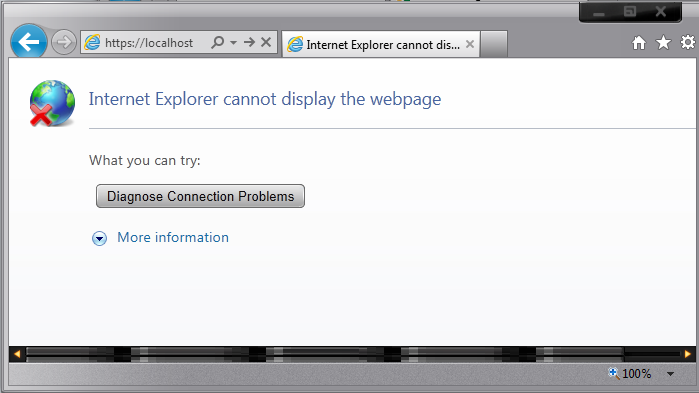
The first pre-requisite that has to be checked is whether the website is accessible over HTTP. If it's not, there likely is a separate issue that's not covered in this article. Before using this troubleshooter, you must have the website operational on HTTP.
Now, let's assume the website is accessible over HTTP and the previous error message is shown when you try to browse over HTTPS. The error message is shown because the SSL handshake failed. There could be many reasons which are detailed in the next few scenarios.
Scenario 1
Check if the server certificate has the private key corresponding to it. See the following screenshot of the Certificate dialog:
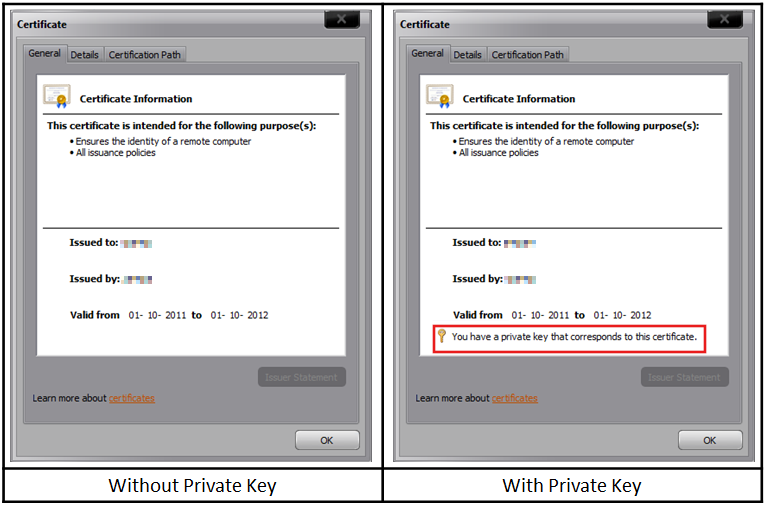
Resolution
If private key is missing, then you need to get a certificate that contains the private key, which is essentially a .PFX file. Here's a command that you could try to run to associate the private key with the certificate::
C:\>certutil - repairstore my "[U+200E] 1a 1f 94 8b 21 a2 99 36 77 a8 8e b2 3f 42 8c 7e 47 e3 d1 33"

If the association is successful, then you would see the following window:
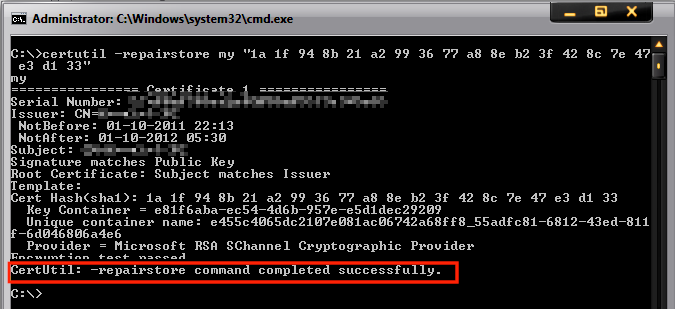
In this example, 1a 1f 94 8b 21 a2 99 36 77 a8 8e b2 3f 42 8c 7e 47 e3 d1 33 is the thumbprint of the certificate. To get the thumbprint:
- Open the certificate.
- Select the Details tab.
- Scroll down to find the thumbprint section.
- Select the thumbprint section and click on the text below.
- Do a Ctrl+A and then Ctrl+C to select and copy it.
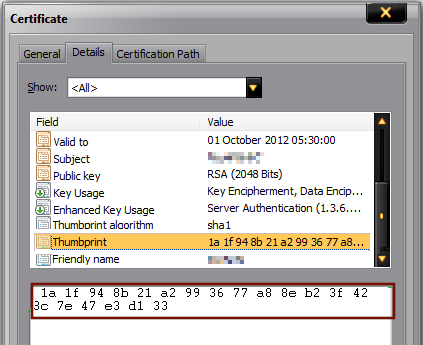
Note
The certutil command may not always succeed. If this fails, then you need to get a certificate containing the private key from the certification authority (CA).
Scenario 2
In this scenario, consider that you have a server certificate that contains the private key installed on the website. However, you continue to see the error shown in scenario 1. You still can't access the website over HTTPS.
Resolution
Download and install SSL Diagnostics tool on the server.
If you have a certificate that contains the private key and you're still unable to access the website, then try running this tool or check the system event logs for SChannel related warnings or errors.
While running the SSLDiag tool, you may see the following error message:
You have a private key that corresponds to this certificate but CryptAcquireCertificatePrivateKey failed.
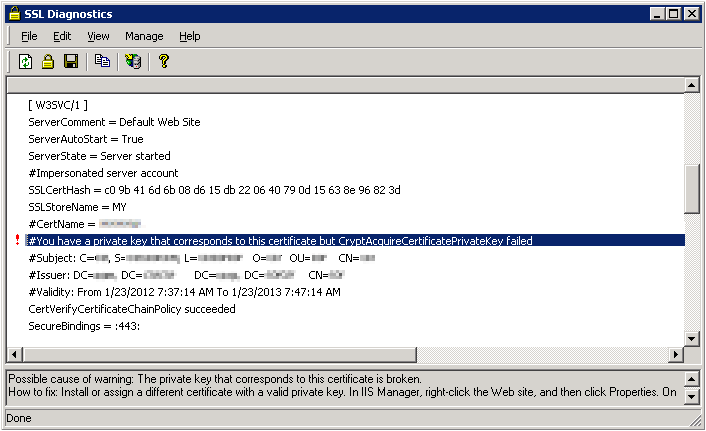
Additionally, the following SChannel warning will appear in the system event logs:
Event Type: Error Event Source: Schannel Event Category: None Event ID: 36870 Date: 2/11/2012 Time: 12:44:55 AM User: N/A Computer: Description: A fatal error occurred when attempting to access the SSL server credential private key. The error code returned from the cryptographic module is 0x80090016.This event or error indicates that there was a problem acquiring certificate's private key. So, try the following steps to resolve the warning:
First, verify the permissions on the MachineKeys folder. All the private keys are stored within the MachineKeys folder, so make sure you have the necessary permissions.
If the permissions are in place and if the issue is still not fixed, then there might be a problem with the certificate. It might have been corrupted. You may see an error code of 0x8009001a in the following SChannel event log:
Event Type: Error Event Source: Schannel Event Category: None Event ID: 36870 Date: 2/11/2012 Time: 12:44:55 AM User: N/A Computer: A fatal error occurred when attempting to access the SSL server credential private key. The error code returned from the cryptographic module is 0x8009001a.Check if the website works with a test certificate.
Take a backup of the existing certificate and then replace it with a self-signed certificate.
Try accessing the website using HTTPS. If it works, then the certificate used earlier was corrupted and it has to be replaced with a new working certificate. Sometimes, the problem may not be with the certificate but with the issuer. You may see the following error in SSLDiag:
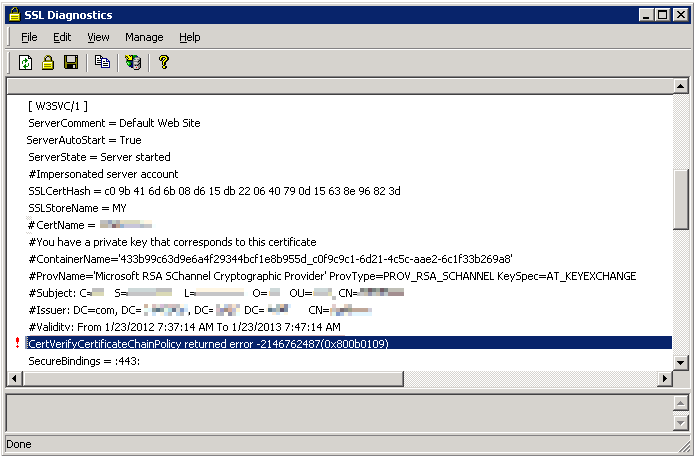
CertVerifyCertificateChainPolicywill fail withCERT_E_UNTRUSTEDROOT (0x800b0109), if the root CA certificate isn't trusted root.To fix this error, add the CA's certificate to the "Trusted Root CA" store under My computer account on the server. You may also get the following error:
CertVerifyCertificateChainPolicy returned error -2146762480(0x800b0110).
To resolve the error, check the usage type of the certificate by doing the following steps:
- Open the certificate.
- Select the Details tab.
- Select Edit Properties….
- Under General tab, make sure that the Enable all purposes for this certificate option is selected and most importantly, the Server Authentication should be present in the list.
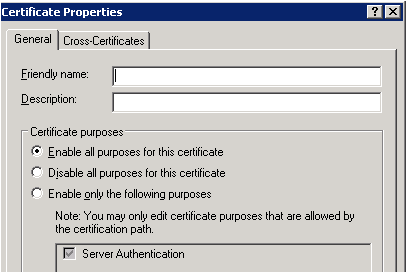
Scenario 3
The first two scenarios helps check the integrity of the certificate. After you confirm there are no issues with the certificate, a sizeable problem is solved. But, what if the website is still not accessible over HTTPS? Check the HTTPS bindings of the website and determine which port and IP it's listening on.
Resolution
Run the following command to make sure that no other process is listening on the SSL port used by the website.
netstat -ano" or "netstat -anobIf there's another process listening on that port, then check why that process is using that port.
Try changing the IP-Port combination to check if the website is accessible.
Scenario 4
By now you can be sure that you have a proper working certificate installed on the website and there's no other process using the SSL port for this website. However, you might still see the "Page cannot be displayed" error while accessing the website over HTTPS. When a client connects and initiates an SSL negotiation, HTTP.sys searches its SSL configuration for the "IP:Port" pair to which the client is connected. The HTTP.sys SSL configuration must include a certificate hash and the name of the certificate store before the SSL negotiation will succeed. The problem may be with the HTTP.SYS SSL Listener.
The Certificate hash registered with HTTP.sys may be NULL or it may contain invalid GUID.
Resolution
Execute the following command:
IIS 6: "httpcfg.exe query ssl" IIS 7/7.5: "netsh http show ssl"Note
HttpCfg is part of Windows Support tools and is present on the installation disk.
Following is a sample of a working and non-working scenario:
Working scenario
Configuration Setting IP 0.0.0.0:443 Hash c09b416d6b 8d615db22 64079d15638e96823d Guid {4dc3e181-e14b-4a21-b022-59fc669b0914} CertStoreName MY CertCheckMode 0 RevocationFreshnessTime 0 UrlRetrievalTimeout 0 SslCtlIdentifier 0 SslCtlStoreName 0 Flags 0 Non-working scenario
Configuration Setting IP 0.0.0.0:443 Hash Guid {00000000-0000-0000-0000-000000000000} CertStoreName MY CertCheckMode 0 RevocationFreshnessTime 0 UrlRetrievalTimeout 0 SslCtlIdentifier 0 SslCtlStoreName 0 Flags 0 The Hash value seen in Working scenario is the Thumbprint of your SSL certificate. Notice, that the GUID is all zero in a non-working scenario. You may see the Hash either having some value or blank. Even if you remove the certificate from the website, and then run
httpcfg query ssl, the website will still list GUID as all 0s. If you see the GUID as "{0000...............000}", then there's a problem.Remove this entry by running the following command:
httpcfg delete ssl -i "IP:Port Number"For example:
httpcfg delete ssl -i 0.0.0.0:443To determine whether any IP addresses are listed, open a command prompt, and then run the following commands:
IIS 6: httpcfg query iplistenIIS 7/7.5: netsh http show iplistenIf the IP Listen list is empty, the command returns the following string:
HttpQueryServiceConfiguration completed with 1168.If the command returns a list of IP addresses, remove each IP address in the list by using the following command:
httpcfg delete iplisten -i x.x.x.xNote
Restart IIS after this using the
net stop http /ycommand.
Scenario 5
In spite of all this, if you're still unable to browse the website on HTTPS, capture a network trace either from the client or server. Filter the trace by "SSL or TLS" to look at SSL traffic.
Following is a network trace snapshot of a non-working scenario:
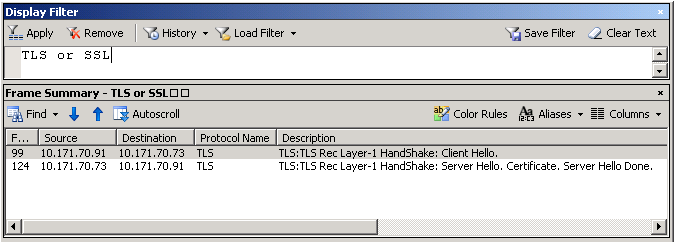
Following is a network trace snapshot of a working scenario:
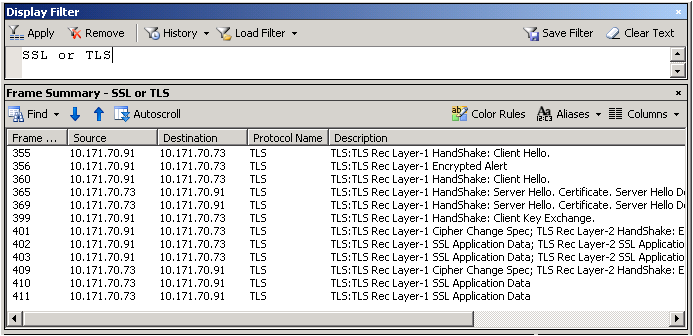
This is the method of how you look at a network trace. You need to expand the frame details and see what protocol and cipher was chosen by the server. Select "Server Hello" from the description to view those details.
In the non-working scenario, the client was configured to use TLS 1.1 and TLS 1.2 only. However, the web server was IIS 6, which can support until TLS 1.0 and hence the handshake failed.
Check the registry keys to determine what protocols are enabled or disabled. Here's the path:
HKEY_LOCAL_MACHINE\SYSTEM\CurrentControlSet\Control\SecurityProviders\SCHANNEL\Protocols
The "Enabled" DWORD should be set to "1". If it's set to 0, then the protocol is disabled.
For example, SSL 2.0 is disabled by default.
Scenario 6
If everything has been verified and if you're still running into issues accessing the website over HTTPS, then it most likely is some update, which is causing the SSL handshake to fail.
Microsoft has released an update to the implementation of SSL in Windows:
MS12-006: Vulnerability in SSL/TLS could allow information disclosure: January 10, 2012
There is potential for this update to impact customers using Internet Explorer or using an application that uses Internet Explorer to perform HTTPS requests.
There were actually two changes made to address information disclosure vulnerability in SSL 3.0 / TLS 1.0. The MS12-006 update implements a new behavior in schannel.dll, which sends an extra record while using a common SSL chained-block cipher, when clients request that behavior. The other change was in Wininet.dll, part of the December Cumulative Update for Internet Explorer (MS11-099), so that Internet Explorer will request the new behavior.
If a problem exists, it may manifest as a failure to connect to a server, or an incomplete request. Internet Explorer 9 and higher is able to display an "Internet Explorer cannot display the webpage" error. Prior versions of Internet Explorer may display a blank page.
Fiddler doesn't use the extra record when it captures and forwards HTTPS requests to the server. Therefore, if Fiddler is used to capture HTTPS traffic, the requests will succeed.
Registry keys
As documented in MS12-006: Vulnerability in SSL/TLS could allow information disclosure: January 10, 2012, there is a SendExtraRecord registry value, which can:
- Globally disable the new SSL behavior,
- Globally enable it, or
- (By default) enable it for SChannel clients that choose the new behavior.
For Internet Explorer and for clients that consume Internet Explorer components, there is a registry key in the FeatureControl section, FEATURE_SCH_SEND_AUX_RECORD_KB_2618444, which determines whether iexplore.exe or any other named application chooses the new behavior. By default, this is enabled for Internet Explorer, and disabled for other applications.